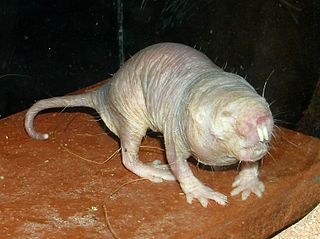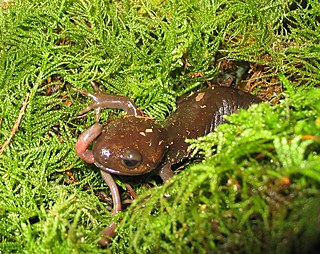Related Research Articles

The naked mole-rat, also known as the sand puppy, is a burrowing rodent native to the Horn of Africa and parts of Kenya, notably in Somali regions. It is closely related to the blesmols and is the only species in the genus Heterocephalus.

The Muroidea are a large superfamily of rodents, including mice, rats, voles, hamsters, lemmings, gerbils, and many other relatives. Although the Muroidea originated in Eurasia, they occupy a vast variety of habitats on every continent except Antarctica. Some authorities have placed all members of this group into a single family, Muridae, due to difficulties in determining how the subfamilies are related to one another. Many of the families within the Muroidea superfamily have more variations between the families than between the different clades. A possible explanation for the variations in rodents is because of the location of these rodents; these changes could have been due to radiation or the overall environment they migrated to or originated in. The following taxonomy is based on recent well-supported molecular phylogenies.

Evolutionary medicine or Darwinian medicine is the application of modern evolutionary theory to understanding health and disease. Modern biomedical research and practice have focused on the molecular and physiological mechanisms underlying health and disease, while evolutionary medicine focuses on the question of why evolution has shaped these mechanisms in ways that may leave us susceptible to disease. The evolutionary approach has driven important advances in the understanding of cancer, autoimmune disease, and anatomy. Medical schools have been slower to integrate evolutionary approaches because of limitations on what can be added to existing medical curricula. The International Society for Evolution, Medicine and Public Health coordinates efforts to develop the field. It owns the Oxford University Press journal Evolution, Medicine and Public Health and The Evolution and Medicine Review.

Spalax is a genus of rodent in the family Spalacidae, subfamily Spalacinae. It is one of two extant genera in the subfamily Spalacinae, alongside Nannospalax.
Richard D. Alexander was an American zoologist who was a professor at the University of Michigan and curator at the university's museum of zoology of in Ann Arbor, Michigan. His scientific pursuits integrated the fields of systematics, ecology, evolution, natural history and behavior. The salient organisms in his research are wide-ranging, from the orthopterans and Cicadidae (cicadas) to vertebrates: dogs, horses, and primates, including humans.

The blesmols, also known as mole-rats, or African mole-rats, are burrowing rodents of the family Bathyergidae. They represent a distinct evolution of a subterranean life among rodents much like the pocket gophers of North America, the tuco-tucos in South America, or the Spalacidae from Eurasia.

The rodent parvorder or infraorder Phiomorpha comprises several living and extinct families found wholly or largely in Africa. Along with Anomaluromorpha and perhaps the extinct Zegdoumyidae, it represents one of the few early colonizations of Africa by rodents.

A fossorial animal is one that is adapted to digging and which lives primarily underground. Examples of fossorial vertebrates are badgers, naked mole-rats, meerkats, armadillos, wombats, and mole salamanders. Among invertebrates, many molluscs, insects, and arachnids are fossorial.
Margaret J. "Margie" Profet is an American evolutionary biologist with no formal biology training who created a decade-long controversy when she published her findings on the role of Darwinian evolution in menstruation, allergies and morning sickness. She argued that these three processes had evolved to eliminate pathogens, carcinogens and other toxins from the body.

Sociality is the degree to which individuals in an animal population tend to associate in social groups (gregariousness) and form cooperative societies.

The Damaraland mole-rat, Damara mole rat or Damaraland blesmol, is a burrowing rodent found in southern Africa. Along with the smaller, less hairy, naked mole rat, it is a species of eusocial mammal.

The Middle East blind mole-rat or Israel mole-rat is a species of rodent in the family Spalacidae.

Rodents are mammals of the order Rodentia, which are characterized by a single pair of continuously growing incisors in each of the upper and lower jaws. About 40% of all mammal species are rodents. They are native to all major land masses except for New Zealand, Antarctica, and several oceanic islands, though they have subsequently been introduced to most of these land masses by human activity.

Eusociality is the highest level of organization of sociality. It is defined by the following characteristics: cooperative brood care, overlapping generations within a colony of adults, and a division of labor into reproductive and non-reproductive groups. The division of labor creates specialized behavioral groups within an animal society which are sometimes referred to as 'castes'. Eusociality is distinguished from all other social systems because individuals of at least one caste usually lose the ability to perform behaviors characteristic of individuals in another caste. Eusocial colonies can be viewed as superorganisms.
When discussing population dynamics, behavioral ecology, and cell biology, recruitment refers to several different biological processes. In population dynamics, recruitment is the process by which new individuals are added to a population, whether by birth and maturation or by immigration. When discussing behavioral ecology and animal communication, recruitment is communication that is intended to add members of a group to specific tasks. Finally, when discussing cell biology, recruitment is the process by which cells are selected for certain tasks.

Vermivore is a zoological term for animals that eat worms. Animals with such a diet are known to be vermivorous. Some definitions are less exclusive with respect to the diet, but limit the definition to particular animals, e.g. "Feeding on worms or insect vermin. Used of a bird."

Eusociality evolved repeatedly in different orders of animals, notably termites and the Hymenoptera. This 'true sociality' in animals, in which sterile individuals work to further the reproductive success of others, is found in termites, ambrosia beetles, gall-dwelling aphids, thrips, marine sponge-dwelling shrimp, naked mole-rats, and many genera in the insect order Hymenoptera. The fact that eusociality has evolved so often in the Hymenoptera, but remains rare throughout the rest of the animal kingdom, has made its evolution a topic of debate among evolutionary biologists. Eusocial organisms at first appear to behave in stark contrast with simple interpretations of Darwinian evolution: passing on one's genes to the next generation, or fitness, is a central idea in evolutionary biology.

Rochelle Buffenstein is an American comparative biologist currently working as Research Professor at the University of Illinois Chicago. Previously, she was a senior principal investigator at Calico Life Sciences, an Alphabet, Inc. funded research and development company investigating the biology that controls aging and lifespan where she used the extraordinarily long-lived cancer resistant naked mole-rat as an attractive counter-example to the inevitability of mammalian aging; for at ages greatly exceeding the expected maximum longevity for this mouse-sized rodent, they fail to exhibit meaningful changes in age-related risk of dying or physiological decline. As such these rodents likely provide the blueprint for how to stave off myriad adverse effects of aging and provide proof of concept that age-related health decline can be avoided in humans.

In behavioral ecology, polyandry is a class of mating system where one female mates with several males in a breeding season. Polyandry is often compared to the polygyny system based on the cost and benefits incurred by members of each sex. Polygyny is where one male mates with several females in a breeding season . A common example of polyandrous mating can be found in the field cricket of the invertebrate order Orthoptera. Polyandrous behavior is also prominent in many other insect species, including the red flour beetle, the adzuki bean weevil, and the species of spider Stegodyphus lineatus. Polyandry also occurs in some primates such as marmosets, mammal groups, the marsupial genus' Antechinus and bandicoots, around 1% of all bird species, such as jacanas and dunnocks, insects such as honeybees, and fish such as pipefish.
Eileen A. Lacey (1961) is an American biologist who specializes in the evolution of behavioral diversity among vertebrates. Lacey’s research focuses on identifying ecological causes of sociality and assessing the genetic consequences of sociality in subterranean rodents. She is most known for her research on the social structure of naked mole rats and her arguments regarding the eusociality continuum
References
- ↑ "Paul Sherman". Department of Neurobiology and Behavior. Retrieved 2023-08-25.
- 1 2 Brody, Jane E. (2000-06-06). "PERSONAL HEALTH; What Could Be Good About Morning Sickness? Plenty". The New York Times. ISSN 0362-4331 . Retrieved 2023-08-25.
- 1 2 "Protecting Ourselves from Food". American Scientist . 2017-02-06. Retrieved 2023-08-25.
- ↑ "Prof. Paul Sherman". HSTalks. Retrieved 2023-08-25.
- ↑ "Paul W. Sherman". John Simon Guggenheim Memorial Foundation... Retrieved 2023-08-25.
- ↑ "Paul Sherman CV". cornell.app.box.com. Retrieved 2023-08-25.
- ↑ "Naked mole-rats share food with a chirp and a wave Cornell study of social rodents traces recruits' route to roots". Cornell Chronicle. Retrieved 2023-08-25.
- ↑ Gadagkar, Raghavendra (2021-03-03). "More Fun Than Fun: The Unlikely Stardom of the Naked Mole Rat – The Wire Science" . Retrieved 2023-08-25.